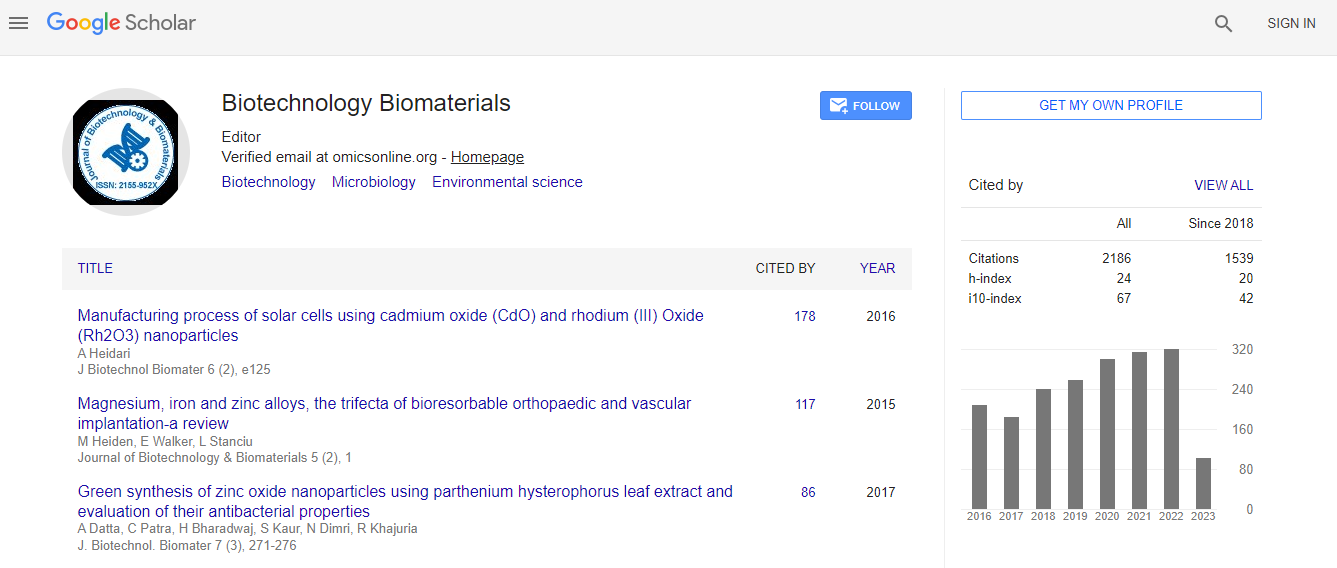Our Group organises 3000+ Global Conferenceseries Events every year across USA, Europe & Asia with support from 1000 more scientific Societies and Publishes 700+ Open Access Journals which contains over 50000 eminent personalities, reputed scientists as editorial board members.
Open Access Journals gaining more Readers and Citations
700 Journals and 15,000,000 Readers Each Journal is getting 25,000+ Readers
Google Scholar citation report
Citations : 3330
Journal of Biotechnology & Biomaterials received 3330 citations as per Google Scholar report
Indexed In
- Index Copernicus
- Google Scholar
- Sherpa Romeo
- Open J Gate
- Genamics JournalSeek
- Academic Keys
- ResearchBible
- China National Knowledge Infrastructure (CNKI)
- Access to Global Online Research in Agriculture (AGORA)
- Electronic Journals Library
- RefSeek
- Hamdard University
- EBSCO A-Z
- OCLC- WorldCat
- SWB online catalog
- Virtual Library of Biology (vifabio)
- Publons
- Geneva Foundation for Medical Education and Research
- Euro Pub
- ICMJE
Useful Links
Recommended Journals
Related Subjects
Share This Page
Guidelines for engineering of probiotics
Biotechnology World Convention
Rob te Biesebeke
InnovationWorks, Switzerland
Posters & Accepted Abstracts: J Biotechnol Biomater
Abstract
Probiotics are defined as live microorganisms that, when administered in adequate amounts, confer a health benefit on the host. Recent research has suggested that probiotics exert a wide range of effects through different mechanisms and sites of action, dependent on the host. Although the European Food Safety Agency has evaluated current probiotic strains insufficient characterized and clinical research ample for health claim approval, consumers (e.g., in the US) are interested in potential therapeutic and preventive health benefits. The Food and Agriculture Organization of the United Nations and the World Health Organization provide guidelines for probiotics: Proper identification to the level of strain of all probiotics in the product, with deposit of all strains in an international culture collection; Characterization of each strain for traits important to its safety and function; Validation of health benefits in human studies, including identification of the quantity of the microorganism required to provide the benefit and; Truthful and not misleading labeling of efficacy claims and content through the end of shelf life. Over the last years we have seen examples of genetically modified strains with adapted physiological properties compared to the parenteral strain and these provide a start for prosperous future developments. The genetic modifications can impact improved survival/retention in the gastrointestinal tract, cell cycle, cell wall, antibiotic resistance and biochemical/metabolic properties of the strains. The current guidelines that any strain of microorganism that would be assigned to a group would be freed from the need for further safety assessment is insufficient to guarantee any health impact in short and long term. It is therefore crucial that improved guidelines allow flexible developments to secure quality and safety, specifically when it concerns infants and premature infants or metabolically compromised individuals and when it concerns the possible long-term effects.Biography
Email: tebiesebeke@yahoo.com

 Spanish
Spanish  Chinese
Chinese  Russian
Russian  German
German  French
French  Japanese
Japanese  Portuguese
Portuguese  Hindi
Hindi 
